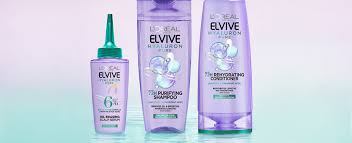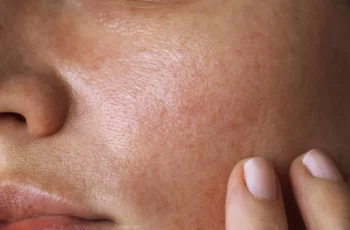Is Salicylic Acid Good for Oily Hair?
I know what you’re thinking right now? Salicylic acid is a powerful ingredient that’s found in your favorite skincare products, but not in haircare products. But believe it or not, when it comes to hair, the scalp is almost always forgotten. This is a shame, of course, because the roots of the hair follicles determine the overall health of your hair, and taking time to care for your scalp and split ends should be one of our top priorities. So, we decided to focus on today’s topic, as salicylic acid is surprisingly found in many shampoo formulas, especially those designed to combat oily hair and dandruff issues.
Salicylic acid is beneficial for the health of your hair and scalp because it exfoliates the skin and sloughs off dead skin cells. This happens not only on the face, but also on the scalp, as salicylic acid breaks down the attachment of dead skin cells to the outer surface. These cells are the cause of dandruff and other flakes. You may find that salicylic acid provides relief, but be careful: if you have a dry or sensitive scalp, it’s best to avoid salicylic acid altogether. Now that you understand how salicylic acid works on your hair, let’s take a closer look at whether salicylic acid is good for oily hair.
Does salicylic acid help with oily hair?
Yes, it absolutely does! Salicylic acid can help improve oily hair in a variety of ways. Here are some of the key benefits of using a smart BHA on your scalp and hair.
Salicylic acid can penetrate your scalp
Since salicylic acid is oil-soluble, it can penetrate deep into the skin and remove layers of dead skin cells to reveal a layer of healthy skin cells underneath. You’ll find your scalp feels more comfortable, but it’s best to avoid using high levels of salicylic acid at first, as it can overly dry out the scalp. Instead, work your way up to your skin’s tolerance for an effective BHA.
Salicylic acid can reduce dandruff
Dandruff often occurs when a layer of dead skin cells on the scalp is left untreated. This can cause an itchy and flaky scalp, and in some extreme cases, can lead to hair breakage. The introduction of hair care products with low salicylic acid content not only stimulates the exfoliation of the scalp, but also treats dandruff at the same time.
These are some of the main benefits of using salicylic acid for oily hair, but if you find that salicylic acid is too strong for your scalp, don’t hesitate to ask your hairdresser for alternatives.
Does salicylic acid damage your hair?
Not really. As effective as salicylic acid is for your skin, you’ll find it to be a completely safe addition to your hair care routine. You’ll find that it effectively removes dry skin from your scalp, reducing signs of dandruff and any irritation or itching caused by this condition. Salicylic acid is also paraben-free, meaning it won’t balance or damage your scalp or hair follicles, making it an easy and effective addition to your daily hair care routine. In fact, after a few weeks of using salicylic acid, you may notice an improvement in hair growth as well, proving that salicylic acid or its natural alternative, willow bark, won’t damage your hair.
Which ingredients are bad for oily hair?
The key ingredients to avoid when dealing with oily hair, or any other type of hair, are as follows.
Sodium Lauryl Sulfate (SLS)
Sodium Laureth Sulfate
Formaldehyde
Parabens
Diethanolamine (DEA)
Triethanolamine (TEA)
Monoethanolamine (MEA)
Propylene glycol
Synthetic fragrance
If you use traditional shampoo and conditioner, you will find it difficult to avoid the ingredients listed above. However, nowadays more than ever, natural shampoos are available in liquid or solid form. As they grow in popularity, many people are benefiting from beautiful curls without harmful chemicals.
Does Salicylic Acid Cleanse Hair?
Yes, as effective as exfoliating BHA is at treating blemishes and keeping skin clear, it can also keep hair healthy and prevent dandruff. It does this by breaking down the bonds of dead skin cells on the surface of the skin and forming a residue. In this residue, you will also find excess sebum, the skin’s natural oil, and if left untreated, the accumulation of sebum can cause the roots of hair to become greasy and difficult to style. In some cases, it can also cause acne on the scalp, also known as folliculitis.
Is Salicylic Acid Bad for the Scalp?
Not at all. In fact, using salicylic acid is very beneficial for your scalp, as its exfoliating properties keep it clean. Healthy, and any signs of dandruff are significantly reduced. Before you run out and buy any hair products you can find that contain salicylic acid, remember to consider the health of your scalp. If it is too dry, it will be too sensitive to the use of BHA, and instead have side effects such as itching, dryness, and flaking. Always consult your doctor before using new products in your daily life.
What should I do if my hair is oily?
There are some simple ways to effectively treat oily hair without causing too many problems. If your hair is oily, here are some examples of home treatments you can try.
Use products formulated specifically for oily hair.
These include salicylic acid or its alternative willow bark, which you now know can effectively treat oily hair and keep your hair clean.
Wash your hair less often
It may be hell for people with oily hair, but washing too often will wash away all the oil from your hair. This will only create more oil, creating a vicious cycle.
Rinse your hair thoroughly
Residue from hair care products means that just washed hair will not stay fresh for long. Always rinse your hair thoroughly to allow more time between washes.
Don’t touch it too often
If you have oily hair, you should try to minimize twirling your hair as this will only make the problem worse, as touching or even combing your hair can stimulate the sebaceous glands and draw excess oil into the hair itself.
Here’s a sneak peek at how this popular skincare product can also be an effective hair treatment. If you want to learn more about salicylic acid and how it works, read our dedicated blog post. Don’t forget to visit us on Instagram if you have any other questions, we can’t wait to hear from you!
DQH Knowledge drop: In your 20s, your skin cell turnover decreases. (Cell turnover is a key component in keeping your skin youthful.) You know what else slows down? Your collagen production. Starting in your 20s, collagen decreases by about 1 percent per year. Should you want to prevent fine lines and wrinkles, start by eliminating behaviors that contribute to premature aging. “If it’s bad for you, it’s bad for your skin,” says dermatologist Michel Somenek.
“Cigarette smoking reduces blood flow to the skin and causes premature wrinkling and a dull skin texture. Making the repeated pursed motion to inhale can also cause smoker’s lines. Alcohol and recreational drugs are toxins for the skin that damage its cellular structure and DNA,” Somenek tells us. “The faster you eliminate vices while you are young, the better chance your skin and body have to recuperate.” Also, adopting an anti-aging routine in your 20s is key. After all, the best offense is a good defense. We spoke to Somenek and experts Joshua Ross and Audrey Kunin to find out more.
Keep reading for the best anti-aging products for your 20s, according to skincare professionals.
Sunscreen
“We all know that the sun is the number one cause of skin aging and starting the prevention in your 20s is very important,” Ross says. “The majority of your sun damage won’t start to appear until you’re in your 30s, so don’t wait until you see it surface or you’ll be behind the curve. Stay ahead of it with a good-quality zinc-based sunscreen worn daily.”
Farmacy Green Defense Daily Mineral Sunscreen
An invisible sunscreen with SPF 30, plus botanical extracts meant to protect skin with tons of antioxidants. Bonus: It’s clean and fine to use under makeup.
Bareminerals Complexion Rescue™ Tinted Moisturizer Broad Spectrum SPF 30
Although we recommend you use your SPF and moisturizer separately, we also understand moments when you don’t have time or energy for that extra step. For those times, this bareMinerals moisturizer is a great thing to have on hand.
Vitamin C Serum
“A great introduction to anti-aging is to start with a vitamin C serum in your morning skincare routine,” Ross says. “It’s a powerful antioxidant that will neutralize free radicals and brighten the skin.” He adds that it’s a great way to counteract the effects of the sun’s harmful rays, which, as previously mentioned, are among the biggest causes of premature aging.
Drunk Elephant C-Firma™ Vitamin C Day Serum
The Drunk Elephant C-Firma is a lightweight serum that promises to give skin a glow by combining the brightening powers of vitamin C with ferulic acid, l-ascorbic acid, and vitamin E. The included sodium hyaluronate is meant to replace hydration loss, so you shouldn’t have to deal with any irritation.
Sunday Riley C.E.O. Rapid Flash Brightening Serum
This potent serum is jam-packed with vitamin C (15 percent, to be exact), which means it’s a potential superstar at both brightening skin and dousing it in antioxidants.
Peptides
Using peptides on your skin has many benefits, says Somenek. “The skin barrier is what defends the body against pollution, UV rays, bacteria, and toxins. It can be damaged by several everyday factors. Using topical peptides aids in building a stronger barrier,” he says. “Peptides comprise elastic fibers, which are a type of protein. These fibers help to make skin appear taut and firm. Peptides can also help repair damaged skin, relieve inflammation, and even out skin tone. Some peptides can kill acne-causing bacteria that is common in 20-somethings.”
Kunin agrees, saying, “Peptides are an excellent entry point for supporting collagen.” She recommends looking for face and eye treatments that contain these collagen-boosting powerhouses.
Charlotte Tilbury Magic Eye Rescue Cream
This Charlotte Tilbury super-emollient eye cream has a base of coconut oil and shea butter (read: it’s incredibly hydrating). Botanicals plus peptides are meant to help reduce dark circles and boost collagen, respectively.
This creamy moisturizer serves up potent collagen-boosting peptides and pycnogenol, and antioxidant-rich vitamin C. “Instead of sitting on top of the skin, peptides penetrate the outer layer so they go deep. The ‘signals’ they send tell the cells to produce elastin and collagen, which are needed for youthful-looking skin,” explains Somenek.
At-Home Peel Pads
Remember that skin cell turnover fiasco we talked about earlier? One way to help support it is by exfoliating. “Exfoliation is important to help keep skin fresh and luminous,” Kunin says. She recommends using at-home peel pads as an easy and effective way to exfoliate.
“The goal in your 20s is to fight the slowing pace of cell turnover. It is wise to use products that gently exfoliate, yet still remove oil and other impurities. Products that have Alpha Hydroxy Acids (AHA) or Beta Hydroxy Acids (BHA) are a good choice.”
According to Somenek, you should only exfoliate two to three times a week. “People of all ages are guilty of over-exfoliating and that can be too much of a good thing,” he says.
Dermadoctor Kakadu C Intensive Vitamin C Peel Pad
A few swipes of this Derma Doctor powerful peel pad promise to leave your skin glowing and smooth, thanks to the seven (yes, seven) types of chemical exfoliants, including AHA and BHA. It also contains vitamin C via Kakadu plum extract for added brightening and antioxidant protection.
KEY INGREDIENTS Kakadu plum extract is sourced from the Kakadu plum, a fruit grown in northern Australia. It contains vitamin C, which restores the skin’s natural barrier, increases collagen production, and soothes irritation.
Dr. Dennis Gross Skincare Alpha Beta® Universal Daily Peel Pads
These are the gold standard of peel pads, with a cult following and over 900 five-star reviews on Sephora. They’re easy to use and contain a blend of anti-aging exfoliating acids.
Emollient Night Cream
“In your 20s, you need to start upping the hydration in your skincare routine. You may have been cautious of over-moisturizing because of acne in your teens, but as you enter your 20s, your skin transitions and becomes drier,” Ross says. “I recommend an emollient night cream added into your evening skincare regimen.”
“Twenty-somethings need to make sure that they are not using creams that will clog their pores and cause excess oil production,” says Somenek. Opt for non-comedogenic products.
Cerave Skin Renewing Night Cream
One great choice is the CeraVe Skin Renewing Night Cream, which is a non-comedogenic night cream that leaves skin soft and glowy. It combines the moisturizing powers of ceramides and hyaluronic acid.
RoC Retinol Correxion Max Hydration Creme
“The best night cream ingredients contain retinol, benzoyl peroxide, and/or salicylic acid or hyaluronic acid. The goal is to moisturize, yet remove excess oil,” says Somenek. This Roc Retinol Correxion cream fits the bill as it contains both hyaluronic acid and retinol so it promises to moisturize while also being non-comedogenic.



